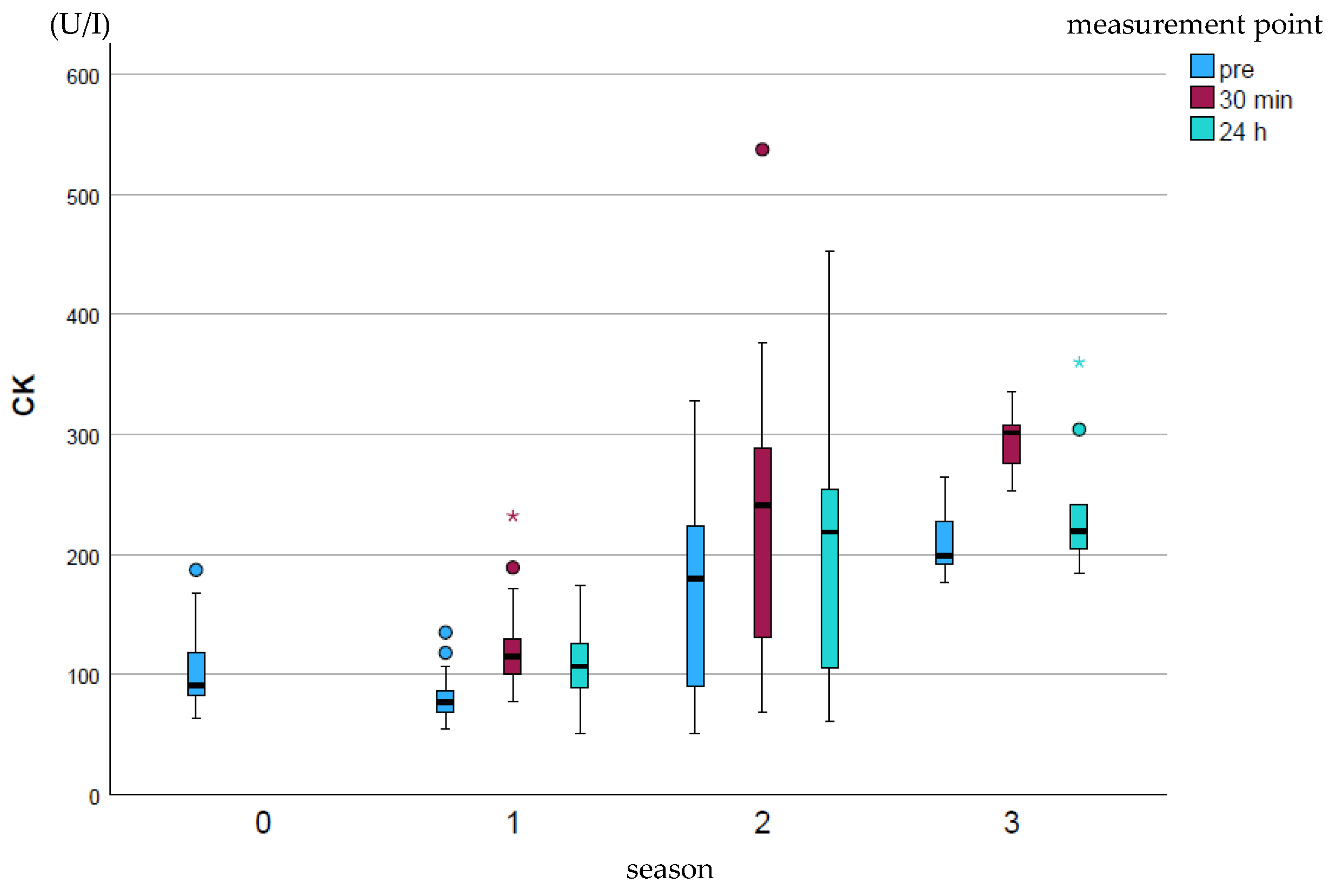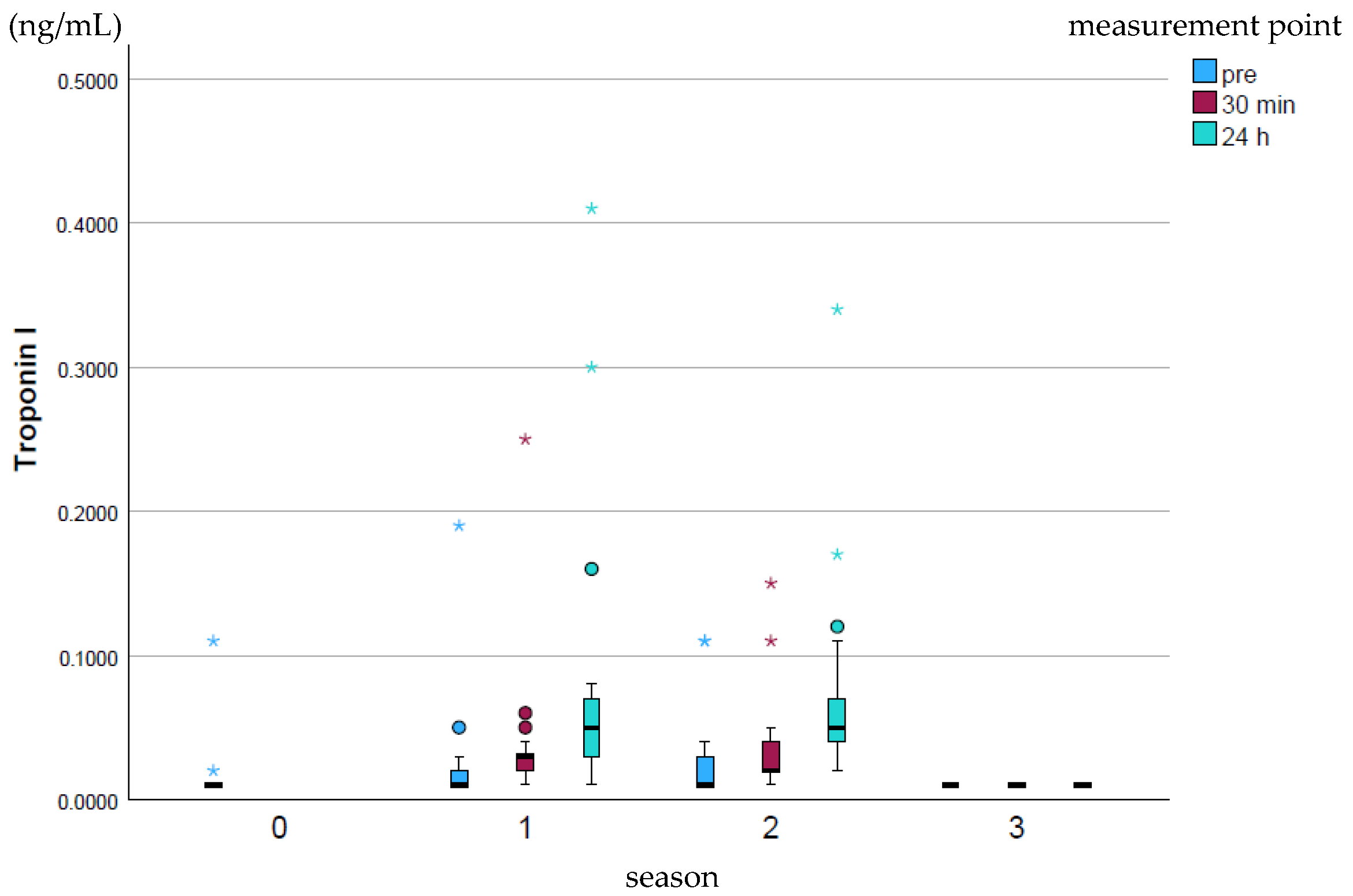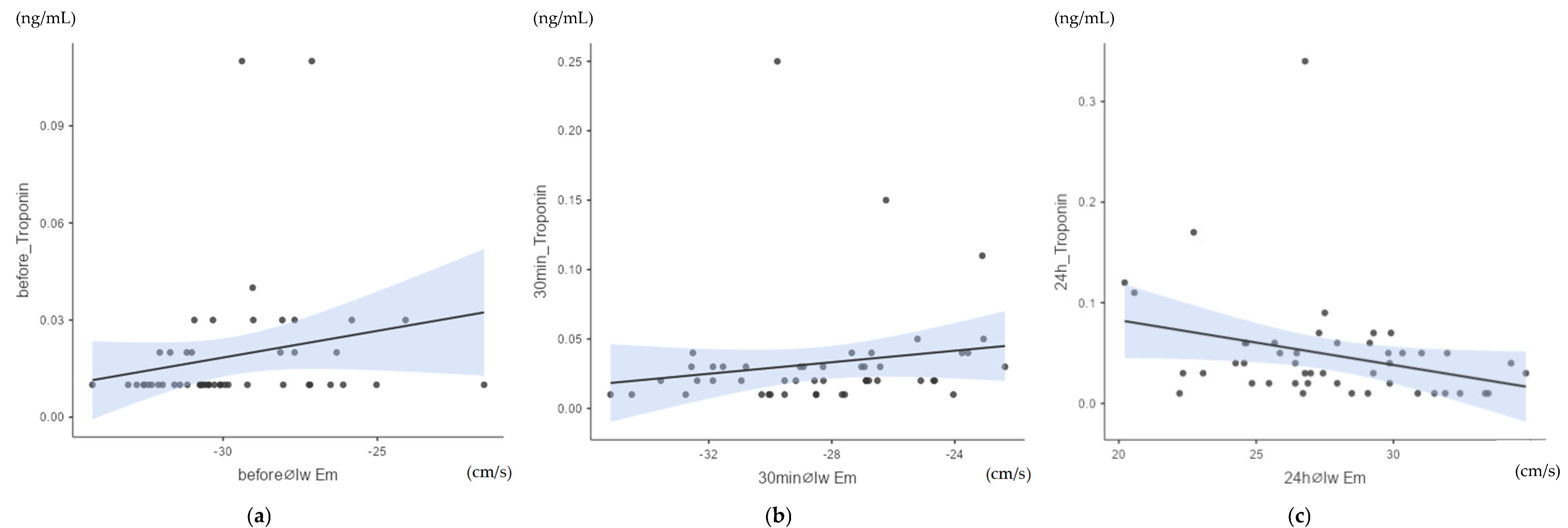Seasonal Trends in Cardiac Troponin I Concentration and Creatine Kinase and Aspartate Aminotransferase Enzyme Activity in Relation to Myocardial Velocity Rates in Eventing Horses
Simple Summary
Abstract
1. Introduction
2. Materials and Methods
2.1. Study Design
2.2. Blood Samples
2.3. Echocardiography
2.4. Data Analysis
3. Results
3.1. Values over the Course of the Season
3.1.1. Creatine Kinase (CK)
3.1.2. Aspartate Aminotransferase
3.1.3. Cardiac Troponin I
3.1.4. Myocardial Velocities
3.2. Correlation of Myocardial Velocities with Cardiac Troponin I
4. Discussion
4.1. Seasonal Progression
4.2. Correlation Between Troponin and Myocardial Velocities
5. Conclusions
Author Contributions
Funding
Institutional Review Board Statement
Informed Consent Statement
Data Availability Statement
Acknowledgments
Conflicts of Interest
Appendix A
Appendix A.1
| Event | Month | Place | Number of Tested Horses | Severity Class | Distance (m) | Velocity (m/min) |
|---|---|---|---|---|---|---|
| 1 | 3 | a | 12 | 2 | 3401 | 550 |
| 2 | 4 | f | 5 | 2 | 3425 | 550 |
| 4 | f | 1 | 3 | 3000 | 520 | |
| 3 | 4 | a | 2 | 3 | 3000 | 520 |
| 4 | 5 | b | 1 | 3 | 3787 | 520 |
| 7 | 1 | 3705 | 570 | |||
| 5 | 6 | a | 3 | 1 | 3772 | 570 |
| 6 | 6 | a | 2 | 2 | 3364 | 550 |
| 3 | 2 | 4455 | 550 | |||
| 7 | 7 | d | 2 | 3 | 2661 | 520 |
| 6 | 2 | 3538 | 550 | |||
| 8 | 8 | c | 5 | 1 | 3580 | 570 |
| 3 | 2 | 3470 | 550 | |||
| 1 | 3 | 3087 | 520 | |||
| 9 | 9 | e | 1 | 3 | 2550 | 500 |
Appendix A.2
| preølw Sm | preølw EM | preølw Am | preøIVS Sm | preøIVS Em | preøIVS Am | pre-cTnI | ||||||||
| scc * | p-Value | scc | p-Value | scc | p-Value | scc | p-Value | scc | p-Value | scc | p-Value | scc | p-Value | |
| pre-cTnI | −0.247 | 0.087 | 0.323 | 0.024 | −0.165 | 0.257 | −0.154 | 0.292 | 0.054 | 0.711 | 0.127 | 0.385 | 1.000 | |
| preøIVS Am | 0.284 | 0.048 | 0.032 | 0.829 | −0.335 | 0.019 | 0.128 | 0.380 | 0.239 | 0.098 | 1.000 | |||
| preøIVS Em | 0.138 | 0.343 | 0.133 | 0.362 | −0.069 | 0.639 | −0.082 | 0.574 | 1.000 | |||||
| preøIVS Sm | 0.162 | 0.265 | 0.021 | 0.884 | −0.240 | 0.097 | 1.000 | |||||||
| preølw Am | −0.074 | 0.615 | −0.147 | 0.314 | 1.000 | |||||||||
| preølw Em | −0.267 | 0.063 | 1.000 | |||||||||||
| preølw Sm | 1.000 | |||||||||||||
| p30ølw Sm | p30ølw EM | p30ølw Am | p30øIVS Sm | p30øIVS Em | p30øIVS Am | p30-cTnI | ||||||||
| scc * | p-Value | scc | p-Value | scc | p-Value | scc | p-Value | scc | p-Value | scc | p-Value | scc | p-Value | |
| p30-cTnI | 0.021 | 0.888 | 0.357 | 0.013 | −0.036 | 0.811 | −0.238 | 0.103 | 0.102 | 0.490 | −0.086 | 0.560 | 1.000 | |
| p30øIVS Am | 0.088 | 0.554 | −0.162 | 0.193 | −0.006 | 0.965 | −0.441 | 0.002 | 0.253 | 0.082 | 1.000 | |||
| p30øIVS Em | −0.305 | 0.035 | 0.111 | 0.451 | 0.079 | 0.593 | −0.111 | 0.451 | 1.000 | |||||
| p30øIVS Sm | −0.108 | 0.466 | −0.368 | 0.010 | −0.247 | 0.091 | 1.000 | |||||||
| p30ølw Am | −0.223 | 0.128 | 0.245 | 0.093 | 1.000 | |||||||||
| p30ølw Em | −0.106 | 0.474 | 1.000 | |||||||||||
| p30ølw Sm | 1.000 | |||||||||||||
| p24ølw Sm | p24ølw EM | p24ølw Am | p24øIVS Sm | p24øIVS Em | p24øIVS Am | p24-cTnI | ||||||||
| scc * | p-Value | scc | p-Value | scc | p-Value | scc | p-Value | scc | p-Value | scc | p-Value | scc | p-Value | |
| p24-cTnI | −0.133 | 0.372 | −0.300 | 0.040 | 0.210 | 0.156 | 0.167 | 0.262 | 0.131 | 0.380 | 0.282 | 0.055 | 1.000 | |
| p24øIVS Am | −0.003 | 0.983 | −0.324 | 0.026 | 0.086 | 0.567 | −0.011 | 0.939 | 0.064 | 0.667 | 1.000 | |||
| p24øIVS Em | −0.035 | 0.814 | 0.079 | 0.600 | 0.169 | 0.257 | 0.046 | 0.757 | 1.000 | |||||
| p24øIVS Sm | −0.084 | 0.577 | −0.099 | 0.507 | −0.137 | 0.358 | 1.000 | |||||||
| p24ølw Am | 0.346 | 0.017 | 0.235 | 0.112 | 1.000 | |||||||||
| p24ølw Em | 0.613 | ≤0.001 | 1.000 | |||||||||||
| p24ølw Sm | 1.000 | |||||||||||||
References
- Buckley, P.; Buckley, D.J.; Freire, R.; Hughes, K.J. Pre-race and race management impacts serum muscle enzyme activity in Australian endurance horses. Equine Vet. J. 2022, 54, 895–904. [Google Scholar] [CrossRef]
- Giers, J.; Bartel, A.; Kirsch, K.; Müller, S.F.; Horstmann, S.; Gehlen, H. Blood-Based Markers for Skeletal and Cardiac Muscle Function in Eventing Horses before and after Cross-Country Rides and How They Are Influenced by Plasma Volume Shift. Animals 2023, 13, 3110. [Google Scholar] [CrossRef]
- Siciliano, P.; Lawrence, L.; Danielsen, K.; Powell, D.; Thompson, K. Effect of conditioning and exercise type on serum creatine kinase and aspartate aminotransferase activity. Equine Vet. J. 2010, 27, 243–247. [Google Scholar] [CrossRef]
- Lindner, A.; Hatzipanagiotou, A. Effect of age and of performance parameters on CK, LDH and AST activities in plasma of standardbred horses during exercise. Pferdeheilkunde Equine Med. 1998, 14, 456–460. [Google Scholar] [CrossRef]
- Vranković, L.; Aladrović, J.; Beer-Ljubić, B.; Zdelar-Tuk, M.; Stojević, Z. Seasonal changes in enzyme activities and mineral concentrations in Holstein stallion blood plasma. Vet. Arhiv. 2015, 85, 235–246. [Google Scholar]
- Volfinger, L.; Lassourd, V.; Michaux, J.M.; Braun, J.P.; Toutain, P.L. Kinetic evaluation of muscle damage during exercise by calculation of amount of creatine kinase released. Am. J. Physiol. 1994, 266, R434–R441. [Google Scholar] [CrossRef]
- Brehm, W.; Gehlen, H.; Ohnesorge, B.; Wehrend, A.; Dietz, O.; Huskamp, B.; Bartmann, C.P. (Eds.) Handbuch Pferdepraxis. 4; Vollständig Überarbeitete und Erweiterte Auflage ed.; 1239 Seiten; Enke: Stuttgart, Germany, 2017. [Google Scholar]
- Messner, B. mRNA-Expression der Kardialen Isoformen von Troponin T und Troponin I im Skelettmuskel von Patienten mit Myopathie in Institut für Klinische Chemie und Pathobiochemie; Technische Universität München: Munich, Germany, 2003. [Google Scholar]
- Rossi, T.M.; Kavsak, P.A.; Maxie, M.G.; Pearl, D.L.; Pyle, W.G. Post-exercise cardiac troponin I release and clearance in normal Standardbred racehorses. Equine Vet. J. 2019, 51, 97–101. [Google Scholar] [CrossRef] [PubMed]
- Foreman, J.H.; Tennent-Brown, B.S.; Oyama, M.A.; Sisson, D.D. Plasma Cardiac Troponin-I Concentration in Normal Horses and in Horses with Cardiac Abnormalities. Animals 2025, 15, 92. [Google Scholar] [CrossRef] [PubMed]
- Keller, T.; Ojeda, F.; Zeller, T.; Wild, P.S.; Tzikas, S.; Sinning, C.R.; Peetz, D.; Münzel, T.; Blankenberg, S.; Lackner, K.J. Defining a reference population to determine the 99th percentile of a contemporary sensitive cardiac troponin I assay. Int. J. Cardiol. 2013, 167, 1423–1429. [Google Scholar] [CrossRef]
- Wijnberg, I.D.; Franklin, S.H. The heart remains the core: Cardiac causes of poor performance in horses compared to human athletes. Comp. Exerc. Physiol. 2017, 13, 149–174. [Google Scholar] [CrossRef]
- Klinke, R.S.S. Lehrbuch der Physiologie; Georg Thieme Verlag: Stuttgart, Germany, 1996; Volume 2. [Google Scholar]
- Greaves, K.; Puranik, R.; O’Leary, J.J.; Celermajer, D.S. Myocardial tissue velocities in the normal left and right ventricle: Relationships and predictors. Heart Lung Circ. 2004, 13, 367–373. [Google Scholar] [CrossRef] [PubMed]
- Tetzner, K. Mehrjähriges Konditionstraining von Sportpferden: Eine Longitudinale Auswertung von Kraft-, Ausdauer-, und Schnelligkeitstraining Anhand von Laktat, Herzfrequenz und Geschwindigkeitsbeziehungen. Ph.D. Thesis, Tierärztliche Hochschule Hannover, Hanover, Germany, 2008. [Google Scholar]
- Ihmels, S. Vergleichende Untersuchungen der Vitalparameter bei Verschiedenen Pferderassen. Ph.D. Thesis, Ludwig-Maximilians-Universität München, Munich, Germany, 2012. [Google Scholar]
- Frenzel, C.; Jensen, K.C.; Gehlen, H. Gewebedopplerechokardiographische Untersuchung der Myokardfunktion und kardialen Ermüdung (cardiac fatigue) beim Vielseitigkeitspferd. Pferdeheilkunde—Equine Med. 2024, 40. [Google Scholar]
- Frenzel, C. Unterschung der Myokardfunktion und kardialen Ermüdung (cardiac fatigue) beim Vielseitigkeitspferd. Doctoral Dissertation, Freie Universität Berlin, Berlin, Germany, 2024. [Google Scholar]
- Yang, N.; Zhang, R.; Zhao, C.; Sun, B.; Wang, B.; Song, Y.; Qi, S.; Liu, J.; Sun, Y.; Liu, H.; et al. Association between Troponin Elevation and Decreased Myocardial Blood Flow Reserve in Patients without Obstructive Coronary Artery Disease. Cardiology 2024, 149, 40–50. [Google Scholar] [CrossRef] [PubMed]
- Röper, T. Prolongiert Erhöhtes Kardiales Troponin als Nachweis Eines Myokardialen Schadens nach Marathon. Ph.D. Thesis, Technische Universität München, Munich, Germany, 2019. [Google Scholar]
- Scharhag, J.U.A.; Kindermann, W. Belastungsinduzierte Veränderungen der kardialen Marker Troponin, Ischämie-modifiziertes Albumin und B-Typ Natriuretisches Peptid. Dtsch. Z. Für Sportmed. 2007, 58, 357–363. [Google Scholar]
- Durrando, M.; Reef, V.; Kline, K.; Birks, E. Acute effects of short duration, maximal exercise on cardiac troponin I in healthy horses. Equine Comp. Exerc. Physiol. 2006, 3, 217–223. [Google Scholar] [CrossRef]
- Pourmohammad, R.; Mohri, M.; Seifi, H.A.; Sardari, K. Evaluation of cardiac troponin I, atrial natriuretic peptide and some oxidative/antioxidative biomarkers in the serum and hemolysate of trained Arabian horses after exercise. Iran. J. Vet. Res. 2020, 21, 211. [Google Scholar]
- Shields, E. ‘High-Sensitivity’ Cardiac Troponin-T Assay Use in Horses: Analytical and Biological Validation, Post-Race Kinetics and Sampling Guidelines. Ph.D. Thesis, University of Calgary, Calgary, AB, Canada, 2016; p. 266. [Google Scholar]
- Lippi, G.; Sanchis-Gomar, F. Cardiac troponins in diagnostics of equine myocardial injury. J. Lab. Precis. Med. 2020, 5, 31. [Google Scholar] [CrossRef]
- Flethøj, M.; Schwarzwald, C.C.; Haugaard, M.M.; Carstensen, H.; Kanters, J.K.; Olsen, L.H.; Buhl, R. Left Ventricular Function After Prolonged Exercise in Equine Endurance Athletes. J. Vet. Intern. Med. 2016, 30, 1260–1269. [Google Scholar] [CrossRef]
- Muñoz, A.; Riber, C.; Santisteban, R.; Lucas, R.G.; Castejón, F.M. Effect of training duration and exercise on blood-borne substrates, plasma lactate and enzyme concentrations in Andalusian, Anglo-Arabian and Arabian breeds. Equine Vet. J. Suppl. 2002, 34, 245–251. [Google Scholar] [CrossRef]
- Shields, E.; Seiden-Long, I.; Massie, S.; Leguillette, R. 24-Hour Kinetics of Cardiac Troponin-T Using a “High-Sensitivity” Assay in Thoroughbred Chuckwagon Racing Geldings after Race and Associated Clinical Sampling Guidelines. J. Vet. Intern. Med. 2018, 32, 433–440. [Google Scholar] [CrossRef]
- Meyer, T.; Meister, S. Routine blood parameters in elite soccer players. Int. J. Sports Med. 2011, 32, 875–881. [Google Scholar] [CrossRef]
- Stavroulakis, G.; George, K. Exercise-induced release of troponin. Clin. Cardiol. 2020, 43, 872–881. [Google Scholar] [CrossRef]
- Munsters, C.; Siegers, E.; Sloet van Oldruitenborgh-Oosterbaan, M. Effect of a 14-Day Period of Heat Acclimation on Horses Using Heated Indoor Arenas in Preparation for Tokyo Olympic Games. Animals 2024, 14, 546. [Google Scholar] [CrossRef]
- Rivero, J.L.; van Breda, E.; Rogers, C.W.; Lindner, A.; Sloet van Oldruitenborgh-Oosterbaan, M. Unexplained underperformance syndrome in sport horses: Classification, potential causes and recognition. Equine Vet. J. 2008, 40, 611–618. [Google Scholar] [CrossRef]
- Klaus, C.S. Gewebedoppler-Echokardiographie (GDE) beim Pferd—Schnittebenen der Myokardialen Wandbewegungsanalyse. Ph.D. Thesis, Freie Universität Berlin, Berlin, Germany, 2009; p. 130. [Google Scholar]
- Moreo, A.; Ambrosio, G.; De Chiara, B.; Pu, M.; Tran, T.; Mauri, F.; Raman, S.V. Influence of myocardial fibrosis on left ventricular diastolic function: Noninvasive assessment by cardiac magnetic resonance and echo. Circ. Cardiovasc. Imaging 2009, 2, 437–443. [Google Scholar] [CrossRef] [PubMed]
- Mandinov, L.; Eberli, F.; Seiler, C.; Hess, O. Diastolic heart failure. Cardiovasc. Res. 2000, 45, 813–825. [Google Scholar] [CrossRef] [PubMed]
- Zile, M.R.; Brutsaert, D.L. New Concepts in Diastolic Dysfunction and Diastolic Heart Failure: Part I. Circulation 2002, 105, 1387–1393. [Google Scholar] [CrossRef] [PubMed]





| AST (U/I) | CK (U/I) | cTroponin I (ng/mL) | |
|---|---|---|---|
| n | 175 | 175 | 175 |
| missing | 0 | 0 | 0 |
| mean value | 241 | 167 | 0.037 |
| median | 183 | 153 | 0.020 |
| standard deviation | 133 | 88,5 | 0.055 |
| minimum | 112 | 51 | 0.010 |
| maximum | 841 | 537 | 0.410 |
| ⌀ lw HR (cm/s) | ⌀ lw Sm (cm/s) | ⌀ lw Em (cm/s) | ⌀ lw Am (cm/s) | |
|---|---|---|---|---|
| n | 176 | 176 | 176 | 176 |
| missing | 62 | 62 | 62 | 62 |
| mean value | 35.20 | 10.40 | −27.10 | −9.26 |
| median | 34.20 | 10.70 | −28.50 | −9.32 |
| standard deviation | 12.30 | 2.94 | 7.410 | 3.28 |
| minimum | 0.00 | 0.00 | −36.60 | −17.10 |
| maximum | 73.70 | 16.30 | 0.00 | 0.00 |
| ⌀ IVS HR (cm/s) | ⌀ IVS Sm (cm/s) | ⌀IVS Em (cm/s) | ⌀ IVS Am (cm/s) | |
|---|---|---|---|---|
| n | 176 | 176 | 176 | 176 |
| missing | 62 | 62 | 62 | 62 |
| mean value | 34.60 | −6.78 | 16.10 | 4.18 |
| median | 33.70 | −6.83 | 16.80 | 3.78 |
| standard deviation | 12.50 | 2.61 | 5.08 | 2.28 |
| minimum | 0.00 | −15.30 | 0.00 | 0.00 |
| maximum | 75.30 | 1.63 | 24.30 | 12.30 |
Disclaimer/Publisher’s Note: The statements, opinions and data contained in all publications are solely those of the individual author(s) and contributor(s) and not of MDPI and/or the editor(s). MDPI and/or the editor(s) disclaim responsibility for any injury to people or property resulting from any ideas, methods, instructions or products referred to in the content. |
© 2025 by the authors. Licensee MDPI, Basel, Switzerland. This article is an open access article distributed under the terms and conditions of the Creative Commons Attribution (CC BY) license (https://creativecommons.org/licenses/by/4.0/).
Share and Cite
Rump-Dierig, I.; Giers, J.; Frenzel, C.; Stöckle, S.; Gehlen, H. Seasonal Trends in Cardiac Troponin I Concentration and Creatine Kinase and Aspartate Aminotransferase Enzyme Activity in Relation to Myocardial Velocity Rates in Eventing Horses. Animals 2025, 15, 3198. https://doi.org/10.3390/ani15213198
Rump-Dierig I, Giers J, Frenzel C, Stöckle S, Gehlen H. Seasonal Trends in Cardiac Troponin I Concentration and Creatine Kinase and Aspartate Aminotransferase Enzyme Activity in Relation to Myocardial Velocity Rates in Eventing Horses. Animals. 2025; 15(21):3198. https://doi.org/10.3390/ani15213198
Chicago/Turabian StyleRump-Dierig, Insa, Johanna Giers, Charlotte Frenzel, Sabita Stöckle, and Heidrun Gehlen. 2025. "Seasonal Trends in Cardiac Troponin I Concentration and Creatine Kinase and Aspartate Aminotransferase Enzyme Activity in Relation to Myocardial Velocity Rates in Eventing Horses" Animals 15, no. 21: 3198. https://doi.org/10.3390/ani15213198
APA StyleRump-Dierig, I., Giers, J., Frenzel, C., Stöckle, S., & Gehlen, H. (2025). Seasonal Trends in Cardiac Troponin I Concentration and Creatine Kinase and Aspartate Aminotransferase Enzyme Activity in Relation to Myocardial Velocity Rates in Eventing Horses. Animals, 15(21), 3198. https://doi.org/10.3390/ani15213198







